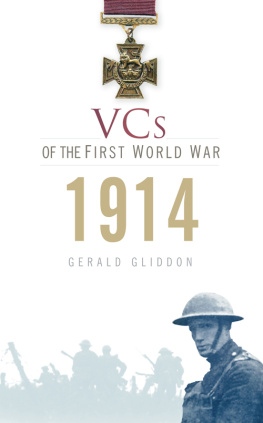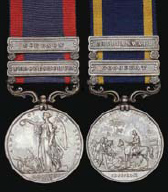BRITISH CAMPAIGN MEDALS OF THE FIRST WORLD WAR
Peter Duckers
SHIRE PUBLICATIONS
CONTENTS
INTRODUCTION
M EDALS FOR WAR SERVICE have been awarded in Britain since the sixteenth century, starting with awards for the Armada campaign in 1588. Over the course of the next two hundred years they were issued sporadically, often unofficially or semi-officially, in small numbers to selected individuals, reflecting no standardised system. Modern medallic awards for operational service are given to all those, regardless of rank or distinction, who were present in a particular campaign for a designated length of time. The first mass awards in these broad terms were made by the Honourable East India Company (HEIC), which began to issue campaign medals on a large scale in the 1780s, presenting silver or gold medals to its Indian (but not European) soldiers for the Deccan campaigns of 177884. The Company continued to make general awards to its Indian soldiers for all its major campaigns until its abolition in 1858 as a result of the Indian Mutiny.
In purely British terms, the silver medal for the Waterloo campaign of 1815 is usually regarded as the first modern medallic award, since it was given to all those present on the campaign, was hung from a distinctive ribbon, was named to its recipient, and was also presented to the next of kin of those who had died. However, it was not until the period 183942, with the large-scale issuing of medals for operations in Afghanistan and for the Opium War with China, that a regulated system of awards came into being. Thereafter, service medals were given to all British forces (and HEIC personnel until 1858) for major operations on land and sea. The idea of clasps silver bars carried on the medal to indicate the recipients presence in a major action originated with the Sutlej Medal for the First Sikh War of 18456. As the British Empire expanded between 1850 and 1914 it became standard practice to award campaign medals with clasps as appropriate, so that there are dozens of different types of medal and hundreds of different clasps reflecting British military operations around the world.
From the mid-nineteenth century, campaign medal designs became standardised: most (but not quite all) were circular and of silver, commonly bearing the recipients details engraved or machine-impressed around the rim. They usually bore the reigning monarchs effigy and titles on one side (the obverse), and a decorative or symbolic design, or sometimes simple wording, on the back (the reverse). They were suspended from a coloured ribbon, whose design was distinctive to that medal or campaign.
An early Honourable East India Company medal the gold award for the Mysore Campaign, 1792.
The first British war medal, for Waterloo, 1815. It bears the effigy of the Prince Regent (later George IV) reigning in place of his incapacitated father, George III.
Medals for the First Sikh War (18456) (left) and the Second Sikh War (18489) (right): the beginnings of standardised medals carrying clasps.
The First World War was the largest conflict that Britain and her Imperial forces had ever faced, involving operations around the world, on land, at sea and in the air, and drawing in civilian populations on a scale never before seen. The British authorities naturally considered the matter of campaign medals while the war was still being fought. It was clear that those who participated should be rewarded with service medals, as well as with any awards for gallant or distinguished service that individuals might earn.
In terms of a general award, it was first proposed to issue medals with campaign or battle clasps, following the precedent of earlier types. The last major campaign before 1914 had been the South African or Boer War of 18991902. This had produced two similar silver medals, one bearing the effigy of Queen Victoria and, since the Queen died while the war was still in progress, another bearing the effigy of her successor, Edward VII. More to the point, the campaign resulted in the authorisation of no fewer than twenty-six separate clasps, reflecting service in large set-piece battles, such as Paardeberg, in sieges and reliefs, as at Ladysmith, Kimberley and Mafeking, in larger-scale operations such as those on the Tugela Heights, or general service over wider areas such as the Orange Free State or the Transvaal.
In 1919 two committees, Army and Navy, investigated the possibility of producing a campaign medal bearing clasps for service in the First World War. Given the scale of the operations, it is not surprising that the War Office committee proposed no fewer than seventy-nine, and the Admiralty sixty-eight. Proposed Army clasps included those for major operations such as Somme 1916 and Gallipoli 1915 and area honours such as France 191415. The Admiraltys proposals were much the same, with clasps for ship-to-ship actions (recalling the days of Nelsons victories!), such as Emden 9 November 1914, or for major fleet actions such as Jutland 31 May 1916, or for operations in support of land service, such as Belgian Coast and Gallipoli Landing. The wider-ranging naval presence above and below the seas was reflected in area clasps such as North Sea 1915 and Home Seas 1918 and in service-specific clasps such as Marmora Submarines or Q Ships. The addition of these clasps to the medals would have added immensely to their historical and personal interest, but it never happened. The complexity of working out who would be entitled to which clasps bearing in mind that they would also be given to Imperial forces and the expense of the project forced its abandonment in 1923. In July 1920, however, the Admiralty published its proposed clasps, so one sometimes sees today, as the only survival of this interesting plan, dress miniatures of the British War Medal bearing naval clasps. These were produced by military tailors anxious to cater for the future demands of their customers and purchased mainly by naval officers for mess dress or formal wear.

South African War medals, 18991902, with examples of the many clasps associated with the awards.
Just as the issue of clasps proved too expensive to proceed with, so the range of medals to be awarded was restricted. Instead of separate medals for naval, military and aerial forces or distinctive awards for different theatres of war (such as a proposed Gallipoli Star), it was decided that all eligible recipients would receive essentially the same medals, regardless of branch of service or theatre of war. A soldier who had served in the Royal Flying Corps in France might receive exactly the same awards as an Indian infantryman for East Africa or an Australian Light Horseman for Palestine or a submariner serving in the Mediterranean. As an extreme example, it was possible for a soldier who had seen only a few weeks service on the North West Frontier of India in 1915 to wear exactly the same three medals as one who had served for four years on the Western Front. This restriction on the range of awards caused some adverse comment, but it was a logical response to a complicated issue.




















